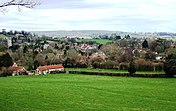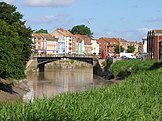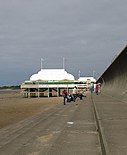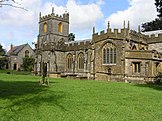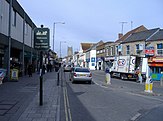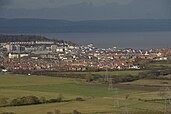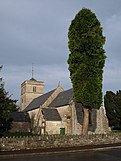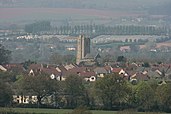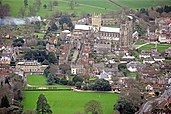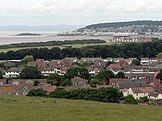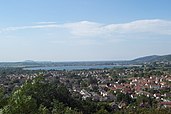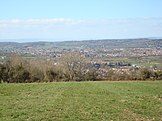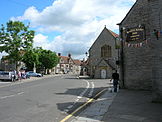Portal:Somerset/Nominate/Selected location
If you wish to add an article for rotation within this portal, please:
- Check its unofficial rating by a WikiProject; it must be B-class or higher to qualify.
- Add the article in to a subpage of this portal, such as Portal:Somerset/Selected location/#, replacing the "#" with the number above the current highest. For example, if 21 articles are in rotation, you would make the number of the article you are creating 22.
- Use the format:
{{Selected location
| image =
| size =
| caption =
| name =
| founded =
| coord =
| text = <!--- Required --->
| link = <!--- Required --->
| archive = no
}}
- Update the article maximum parameter on the main Portal.
- If possible, please accompany the article with a freely-licensed image (such as images released under the GNUFDL, Public Domain.) Fair use images are not permitted, per Wikipedia:Non-free content criteria.
- Update this list accordingly.
Selected article
Bath
Co-ordinates 51°22′51″N 2°21′37″W / 51.3809°N 2.3603°W
Bath is a city in the ceremonial county of Somerset. It is situated 97 miles (156 km) west of London and 13 miles (21 km) south-east of Bristol. The population of the city is 83,992. It was granted city status by Royal Charter by Queen Elizabeth I in 1590, and was made a county borough in 1889 which gave it administrative independence from the county. The city became part of Avon when that county was created in 1974. Since 1996, when Avon was abolished, Bath has been the principal centre of the unitary authority of Bath and North East Somerset (B&NES).
The city was first established as a spa resort with the Latin name, Aquae Sulis ("the waters of Sulis") by the Romans in AD 43 although verbal tradition suggests that Bath was known before then. They built baths and a temple on the surrounding hills of Bath in the valley of the River Avon around hot springs, which are the only ones naturally occurring in the United Kingdom. Edgar was crowned king of England at Bath Abbey in 973. Much later, it became popular as a spa resort during the Georgian era, which led to a major expansion that left a heritage of exemplary Georgian architecture crafted from Bath Stone.
The City of Bath was inscribed as a World Heritage Site in 1987. The city has a variety of theatres, museums, and other cultural and sporting venues, which have helped to make it a major centre for tourism, with over one million staying visitors and 3.8 million day visitors to the city each year. The city has two universities and several schools and colleges. There is a large service sector, and growing information and communication technologies and creative industries, providing employment for the population of Bath and the surrounding area. (Full article...)
Portal:Somerset/Selected location/2
Chew Stoke
Co-ordinates 51°21′03″N 2°38′18″W / 51.3507°N 2.6383°W
Chew Stoke is a small village and civil parish in the Chew Valley, about 8 miles (13 km) south of Bristol. It is at the northern edge of the Mendip Hills, a region designated by the United Kingdom as an Area of Outstanding Natural Beauty, and is within the Bristol/Bath green belt. The parish includes the hamlet of Breach Hill, which is approximately 2 miles (3.2 km) southwest of Chew Stoke itself.
Chew Stoke has a long history, as shown by the number and range of its heritage-listed buildings. The village is at the northern end of Chew Valley Lake, which was created in the 1950s, close to a dam, pumping station, sailing club, and fishing lodge. A tributary of the River Chew, which rises in Strode, runs through the village.
The population of 905 is served by one shop, two public houses, a primary school and a bowling club. Together with Chew Magna, it forms the ward of Chew Valley North in the unitary authority of Bath and North East Somerset. Chew Valley School and its associated leisure centre are less than a mile (1.6 km) from Chew Stoke. The village has some areas of light industry but is largely agricultural; many residents commute to nearby cities for employment. (Full article...)
Portal:Somerset/Selected location/3
Bridgwater
Co-ordinates 51°07′41″N 2°59′35″W / 51.128°N 2.993°W
Bridgwater is a market town and civil parish. It is the administrative centre of the Sedgemoor district, and a major industrial centre. Bridgwater is located on the major communication routes through South West England. According to the 2001 census, the town had a population of 33,698.
Bridgwater is situated, on the edge of the Somerset Levels, in a level and well-wooded country, having to the north the Mendip range and on the west the Quantock hills. The town lies along both sides of the River Parrett, 10 miles (16 km) from its mouth, has been a major port and trading centre and maintains a large industrial base. It is linked to Taunton by the Bridgwater and Taunton Canal. Bridgwater is located between two junctions of the M5 motorway and Bridgwater railway station is on the main railway line between Bristol and Taunton.
Historically, the town had a politically radical tendency, being involved in several events of note on the national stage, and was defended by its own castle. The battlefield of the Battle of Sedgemoor, where the Monmouth Rebellion was finally crushed in 1685 is nearby. Among several places of worship the chief is St Mary Magdalene's church. A house in Blake Street, largely restored, was the birthplace of Admiral Blake in 1598, and is now the Blake Museum. The town has its own arts centre and plays host to the annual Bridgwater Guy Fawkes Carnival. (Full article...)
Portal:Somerset/Selected location/4
Burnham-on-Sea
Co-ordinates 51°14′15″N 2°59′37″W / 51.2376°N 2.9935°W
Burnham-on-Sea is a town at the mouth of the River Parrett on Bridgwater Bay. Burnham was a small village until the late 18th century, when it began to grow because of its popularity as a seaside resort. It forms part of the parish of Burnham-on-Sea and Highbridge. According to the 2001 census the population of the parish was 18,401.
The position of the town on the edge of the Somerset Levels, where they meet the Bristol Channel, has resulted in a history dominated by land reclamation and sea defences since Roman times. Burnham was seriously affected by the Bristol Channel floods of 1607, and various flood defences have been installed since then. In 1911, a concrete sea wall was built, and after the Second World War further additions to the defences were made, using the remains of a Mulberry harbour. The present curved concrete wall was completed in 1988. There have been many shipwrecks on the Gore Sands, which lie just offshore and can be exposed at low tides. The Bridgwater Corporation sent the first lifeboat to Burnham in 1836; the present rescue service is provided by the Burnham-on-Sea Area Rescue Boat. The need to protect shipping using the channel has also led to the development of the lighthouses, which are prominent landmarks. The original lighthouse, known as the Round Tower, was built to replace the light on the top of the 14th-century tower of St Andrews Church. The four-storey round tower was taken over and improved by Trinity House in 1815, and was operational until 1832. The top two storeys were later removed, to prevent confusion with the new lighthouse. The 110 feet (34 m) pillar or High Lighthouse and the low wooden pile lighthouse or Lighthouse on legs on the beach were built to replace it.
A stone pier was built in 1858 by the Somerset Central Railway. Soon afterwards, in 1860, a steamer service to Wales was inaugurated, but it was never a commercial success, and ended in 1888. Burnham-on-Sea railway station was the terminus of the Burnham branch of the Somerset and Dorset Joint Railway. It opened in 1858, closed to scheduled passenger traffic in 1951, and stopped being used for excursions in 1962. The former Great Western Railway station is now known as Highbridge and Burnham. A second pier, built of concrete between 1911 and 1914, is claimed to be the shortest pier in Britain. The town has number of educational, religious and cultural buildings, and sporting clubs. (Full article...)
Portal:Somerset/Selected location/5
Chard
Co-ordinates 50°52′22″N 2°57′31″W / 50.8728°N 2.9587°W
Chard is a town and civil parish. It lies on the A30 road near the Devon border, 15 miles (24 km) south west of Yeovil. The parish has a population of approximately 12,000 and, at an elevation of 121 metres (397 ft), it is the southernmost and highest town in Somerset. Administratively Chard forms part of the district of South Somerset.
The name of the town was Cerden in 1065 and Cerdre in the Domesday Book of 1086. Before the Norman Conquest, Chard was held by the Bishop of Wells. The town's first charter was from King John in 1234. Most of the town was destroyed by fire in 1577, and it was further damaged during the English Civil War. A 1663 will by Richard Harvey of Exeter established Almshouses known as Harvey's Hospital. In 1685 Chard was one of the towns in which Judge Jeffreys held some of the Bloody Assizes after the failure of the Monmouth Rebellion. textile manufacture was important in the Middle Ages. Chard claims to be the birthplace of powered flight and the development of articulated artificial limbs. Chard is a key point on the Taunton Stop Line, a World War II defensive line. The Chard Canal was a tub boat canal built between 1835 and 1842. Chard Branch Line was created in 1860 to connect the two London and South Western Railway and Bristol and Exeter Railway main lines and ran through Chard until 1965.
Local folklore claims that the town has a very unusual and unique feature, a stream running along either side of Fore Street, one stream eventually flows into the Bristol Channel and the other eventually reaches the English Channel. Chard reservoir, approximately a mile north east of the town, is a Local Nature Reserve, and Snowdon Hill Quarry a geological Site of Special Scientific Interest. Major employers in the town include Numatic International Limited and the Oscar Mayer food processing plant.There are a range of sporting and cultural facilities, with secondary education being provided at Holyrood Academy and religious sites including the Church of St Mary the Virgin which dates from the late 11th century. (Full article...)
Portal:Somerset/Selected location/6

Co-ordinates 51°21′55″N 2°36′25″W / 51.3653°N 2.6069°W
Chew Magna is a village and civil parish within the Chew Valley in the Unitary Authority of Bath and North East Somerset. The parish has a population of 1,161. To the south of the village is Chew Valley Lake. The village is on the B3130, about 10 miles (16 km) from Bristol, 15 miles (24 km) from Bath, 13 miles (21 km) from the city of Wells, and 6 miles (10 km) from Bristol International Airport.
It is just on the northern edge of the Mendip Hills (a designated Area of Outstanding Natural Beauty), and was designated a conservation area in 1978. There are many listed buildings reflecting the history of the village. The River Chew flows through the village. Just outside the village is Chew Magna Reservoir. This small Bristol Water supply reservoir intercepts the Winford Brook.
There are two primary schools and a secondary school, several shops and small businesses, three churches, and three pubs serving the area. There is also a football pitch and children's play area. The village frequently wins regional categories in the Calor Village of the Year competition, and is currently moving towards zero waste status, having been described as "probably the greenest parish in Britain". (Full article...)
Portal:Somerset/Selected location/7
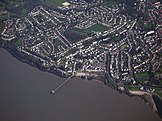
Co-ordinates 51°26′18″N 2°51′14″W / 51.4384°N 2.8539°W
Clevedon is a town and civil parish in the unitary authority of North Somerset. The town has a population of 21,957 according to the United Kingdom Census 2001. The town is situated amongst a group of small hills alongside the River Severn estuary, including Churchill, Wain's hill (which is topped by the remains of an Iron Age hill fort), Dial hill, Strawberry hill, Castle hill, Hangstone hill and Court hill which is a Site of Special Scientific Interest. Clevedon was mentioned in the Domesday Book but did not really grow until the Victorian era when Clevedon became a popular seaside town. It was served by a short branch line from the main railway at Yatton, between 1847 and 1961. Another railway also served the town, the Weston, Clevedon & Portishead Light Railway, which opened in 1897 and closed in 1940.
The seafront includes ornamental gardens, a Victorian bandstand, and other visitor attractions. The Salthouse Field has a light railway running round the perimeter and is used for donkey rides during the summer. The shore is a mixture of pebbled beaches and low rocky cliffs, with the old harbour being at the western edge of the town at the mouth of the Land Yeo. The rocky beach, which has been designated as the Clevedon Shore geological Site of Special Scientific Interest. Clevedon Pier was opened in 1869, one of the earliest examples of a Victorian pier still in existence in the United Kingdom. During the 20th century it fell into disrepair but was dismantled, restored and rebuilt, reopening in 1986. Other landmarks include Walton Castle, Clevedon Court the Clevedon clock tower and the Curzon cinema. Clevedon has a certain amount of light industry, mainly in industrial estates including Hither Green Trading Estate near the M5 motorway junction, and it is also a dormitory town for Bristol. The town is also home to a range of educational, religious and cultural buildings and sporting clubs. (Full article...)
Portal:Somerset/Selected location/8
The Sweet Track is an ancient causeway in the Somerset Levels. It was built in 3807 or 3806 BC and has been claimed to be the oldest road in the world. It was the oldest timber trackway discovered in Northern Europe until the 2009 discovery of a 6,000 year-old trackway in Belmarsh Prison. It is now known that the Sweet Track was largely built over the course of an earlier structure, the Post Track.
The track extended across the marsh between what was then an island at Westhay, although much of the marsh has now been drained, and a ridge of high ground at Shapwick, a distance close to 2,000 metres (6,600 ft). The track is one of a network that once crossed the Somerset Levels. Various artefacts, including a jadeitite axe head, have been found along its length.
Construction was of crossed wooden poles which were driven into the waterlogged soil to support a walkway that consisted mainly of planks of oak, laid end-to-end. The track was only used for a period of around 10 years and then abandoned, probably due to rising water levels. Following its discovery in 1970 most of the track has been left in its original location, with active conservation measures taken, including a water pumping and distribution system to maintain the wood in its damp condition. Some of the track is stored at the British Museum and a reconstruction of a section was built at the Peat Moors Centre near Glastonbury. (Full article...)
Portal:Somerset/Selected location/9
Frome
Co-ordinates 51°13′40″N 2°19′17″W / 51.2279°N 2.3215°W
Frome /ˈfruːm/ ⓘ is a town and civil parish in northeast Somerset. Located at the eastern end of the Mendip Hills, the town is built on uneven high ground, and centres around the River Frome. The town is approximately 13 miles (21 km) south of Bath, 43 miles (69 km) east of the county town, Taunton and 88 miles (142 km) west of London. In the 2001 census, the population was given as 24,510. The town is in the Mendip district of Somerset and is part of the parliamentary constituency of Somerton and Frome.
In April 2010 a large hoard of third-century Roman coins was unearthed in a field near the town. From AD 950 to 1650, Frome was larger than Bath and originally grew due to the wool and cloth industry. It later diversified into metal-working and printing, although these have declined. The town grew substantially in the 20th century but still retains a very large number of listed buildings, and most of the centre falls within a conservation area.
The town has road and rail transport links and acts as an economic centre for the surrounding area. It also provides a centre for cultural and sporting activities, including the annual Frome Festival and Frome Museum. A number of notable individuals were born in, or have lived in, the town. (Full article...)
Portal:Somerset/Selected location/10
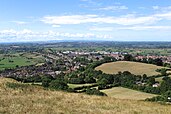
Co-ordinates 51°08′55″N 2°42′50″W / 51.1485°N 2.714°W
Glastonbury is a small town situated at a dry point on the low lying Somerset Levels, 30 miles (48 km) south of Bristol. The town, which is in the Mendip district, had a population of 8,784 in the 2001 census. Glastonbury is less than 1 mile (2 km) across the River Brue from the village of Street. Evidence from timber trackways such as the Sweet Track show that the town has been inhabited since Neolithic times. Glastonbury Lake Village was an Iron Age village, close to the old course of the River Brue and Sharpham Park approximately 2 miles (3.2 km) west of Glastonbury, dates back to the Bronze Age. Centwine was the first Saxon patron of Glastonbury Abbey, which dominated the town for the next 700 years. One of the most important abbeys in England, it was the site of Edmund Ironside's coronation as King of England in 1016. Many of the oldest surviving buildings in the town, including the Tribunal, George Hotel and Pilgrims' Inn and the Somerset Rural Life Museum, which is based in an old tithe barn, are associated with the abbey. The Church of St John the Baptist dates from the 15th century.
The town became a centre for commerce, which led to the construction of the market cross, Glastonbury Canal and the Glastonbury and Street railway station, the largest station on the original Somerset and Dorset Joint Railway. The Brue Valley Living Landscape is a conservation project managed by the Somerset Wildlife Trust and nearby is the Ham Wall National Nature Reserve.
Glastonbury has been described as a New Age community which attracts people with New Age beliefs, and is notable for myths and legends often related to Glastonbury Tor, concerning Joseph of Arimathea, the Holy Grail and King Arthur. In some Arthurian literature Glastonbury is identified with the legendary island of Avalon. Joseph is said to have arrived in Glastonbury and stuck his staff into the ground, when it flowered miraculously into the Glastonbury Thorn. The presence of a landscape zodiac around the town has been suggested, along with a collection of ley lines, but no evidence has been discovered. Glastonbury Festival takes its name from the town but is actually held in the nearby village of Pilton. (Full article...)
Portal:Somerset/Selected location/11
Keynsham
Co-ordinates 51°24′49″N 2°29′48″W / 51.4135°N 2.4968°W
Keynsham /ˈkeɪnʃəm/ is a town and civil parish between Bristol and Bath. It has a population of 15,533. It was listed in the Domesday Book as Cainesham, which is believed to mean the home of Saint Keyne.
The site of the town has been occupied since prehistoric times and is scattered with Roman remains. It became a medieval market town, after Keynsham Abbey was founded around 1170. It is situated at the confluence of the River Chew and River Avon and was subject to serious flooding before the creation of Chew Valley Lake and river level controls at Keynsham Lock. The Great Flood of 1968 inundated large parts of the town. It was home to the Cadbury's chocolate factory, Somerdale, which opened in 1935 as a major employer in the town.
It is home to Memorial Park, which is used for the annual town festival and several nature reserves. The town is served by Keynsham railway station on the London-Bristol and Bristol-Southampton trunk routes and is close to the A4 road which bypassed the town in the 1964. There are also a range of schools, religious sporting and cultural clubs and venues. (Full article...)
Portal:Somerset/Selected location/12
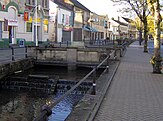
Co-ordinates 51°17′03″N 2°28′54″W / 51.2842°N 2.4817°W
Midsomer Norton is a town in Somerset 10 miles (16.1 km) south-west of Bath, 10 miles (16 km) north-east of Wells, 10 miles (16 km) north-west of Frome, and 16 miles (26 km) south-east of Bristol. It has a population of 10,458. Along with Radstock it is part of the conurbation and large civil parish of Norton Radstock, and the unitary authority of Bath and North East Somerset.
The town, on the Mendip Hills has a long history, shown by the early churches, but really started to grow, and become a transport hub, with the development of the Somerset coalfield with several pits providing employment until their closure in the 1960s. The town's railway stations have also closed. Midsomer Norton is now home to printing and other industries and provides shopping and service industries for the surrounding area.
It has a rich cultural history and supports several music venues and bands. The town has four primary schools, two large secondary schools and a further education college. Midsomer Norton is home to a leisure centre and several sports clubs. It has been the birth place or home to several notable people. (Full article...)
Portal:Somerset/Selected location/13
Minehead
Co-ordinates 51°12′14″N 3°28′26″W / 51.2038°N 3.4738°W
Minehead is a coastal town and civil parish lying on the south bank of the Bristol Channel, 21 miles (34 km) north-west of the county town of Taunton, 12 miles (19 km) from the border with the county of Devon and in proximity of the Exmoor National Park. The parish of Minehead has a population of approximately 10,330 making it the most populous town in the West Somerset local government district. This figure includes Alcombe, a suburban village which has been subsumed into Minehead.
There is evidence of human occupation in the area since the Bronze and Iron Ages. Before the Norman Conquest it was held by Ælfgar, Earl of Mercia and after it by William de Moyon and his descendants, who administered the area from Dunster Castle, which was later sold to Sir George Luttrell and his family. There was a small port at Minehead by 1380, which grew into a major trading centre during the medieval period. Most trade transferred to larger ports during the 20th century, but pleasure steamers did call at the port. Major rebuilding took place in the Lower or Middle town area following a fire in 1791 and the fortunes of the town revived with the growth in sea bathing, and by 1851 was becoming a retirement centre. There was a marked increase in building during the early years of the 20th century, which resulted in the wide main shopping avenue and adjacent roads with Edwardian style architecture. The town's flood defences were improved after a storm in 1990 caused flooding.
Minehead is governed by a town council, which was created in 1983 and has been part of the West Somerset local government district since 1974. In addition to the parish church of St. Michael, Alcombe is home to what used to be the Parish Church in Grove Place which is now a Spiritualist Church. Since 1991, Minehead has been twinned with Saint-Berthevin, a small town close to the regional centre of Laval in the Mayenne département of France. Blenheim Gardens, which is Minehead’s largest park, was opened in 1925. The town is also the home of a Butlins Holiday Park which increases Minehead's seasonal tourist population by several thousand. There are a variety of schools and religious, cultural and sporting facilities including sailing and wind surfing and golf. One popular ancient local tradition involves the Hobby Horse, or Obby Oss, which takes to the streets for four days on the eve of the first of May each year, with accompanying musicians and rival horses. The town is the starting point of the South West Coast Path National Trail, the nation's longest long-distance countryside walking trail. The Minehead Railway was opened in 1874 and closed in 1971 but has since been reopened as the West Somerset Railway. (Full article...)
Portal:Somerset/Selected location/14
Portishead
Co-ordinates 51°29′02″N 2°45′45″W / 51.484°N 2.7626°W
Portishead /pɔːtɪsˈhɛd/ is a coastal town on the Severn Estuary within the unitary authority of North Somerset. It has a population of 22,000, an increase of over 3,000 since the 2001 census, with a growth rate of 40 per cent, considerably in excess of surrounding towns.
Portishead has a long history as a fishing port. It expanded rapidly during the early 19th century around the docks, with supporting transport infrastructure. A power station and chemical works were added in the 20th century, but the dock and industrial facilities have since declined, redeveloped into a marina and residential areas. Portishead was also the telephone control centre used by British Telecom (BT) for non-direct dialled calls to maritime vessels, a service known as Portishead Radio.
The town's population is expanding, served by several retail outlets, religious, educational and sporting venues. Portishead is now primarily a dormitory town for Bristol and its environs, although a range of services industries has grown up. The headquarters of Avon and Somerset Constabulary are based in Portishead. (Full article...)
Portal:Somerset/Selected location/15
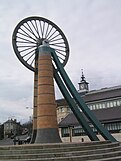
Co-ordinates 51°17′34″N 2°26′52″W / 51.2927°N 2.4477°W
Radstock is a town 9 miles (14 km) south west of Bath, and 8 miles (13 km) north west of Frome. It is within the unitary authority of Bath and North East Somerset and has a population of 5,275 according to the 2001 Census. Together with neighbouring Midsomer Norton and the smaller settlements of Clandown, Westfield and Haydon, Radstock is part of the conurbation and civil parish of Norton Radstock.
Radstock has been settled since the Iron Age, and its importance grew after the construction of the Fosse Way, a Roman road. The growth of the town occurred after 1763, when coal was discovered in the area. Large numbers of mines opened during the 19th century including several owned by the Waldegrave family, who had been Lords of the Manor since the English Civil War. The spoil heap of Writhlington colliery is now the Writhlington Site of Special Scientific Interest, which includes 3,000 tons of Upper Carboniferous spoil from which more than 1,400 insect fossil specimens have been recovered. The complex geology and narrow seams made coal extraction difficult. Tonnage increased throughout the 19th century, reaching a peak around 1901, when there were 79 separate collieries and annual production was 1,250,000 tons per annum. However, due to local geological difficulties and manpower shortages output declined and the number of pits reduced from 30 at the beginning of the 20th century to 14 by the mid-thirties; the last two pits, Kilmersdon and Writhlington, closed in September 1973. The Great Western Railway and the Somerset and Dorset Railway both established stations and marshalling yards in the town. The last passenger train services to Radstock closed in 1966. Manufacturing industries such as printing, binding and packaging provide some local employment. In recent years, Radstock has increasingly become a commuter town for the nearby cities of Bath and Bristol.
Radstock is home to the Radstock Museum which is housed in a former market hall, and has a range of exhibits which offer an insight into north-east Somerset life since the 19th century. Many of the exhibits relate to local geology and the now disused Somerset coalfield and geology. The town is also home to Writhlington School, famous for its Orchid collection, and a range of educational, religious and cultural buildings and sporting clubs. (Full article...)
Portal:Somerset/Selected location/16
Shepton Mallet
Co-ordinates 51°11′33″N 2°32′45″W / 51.1925°N 2.5458°W
Shepton Mallet is a small rural town and civil parish in the Mendip district. Situated approximately 18 mi (29 km) south of Bristol and 5 mi (8.0 km) east of Wells, the town is estimated to have a population of 9,700. It contains the administrative headquarters of Mendip District Council.
The Mendip Hills lie to the north, and the River Sheppey runs through the town. Shepton Mallet lies on the route of the Fosse Way, the principal Roman road into the south west of England, and there is evidence of Roman settlement. The town contains a fine parish church and a considerable number of listed buildings. Shepton Mallet Prison is England's oldest prison still in use.
In medieval times, the wool trade was important in the town's economy, although this declined in the 18th century to be replaced by other industries such as brewing; the town continues to be a major centre for the production of cider. Shepton Mallet is the closest town to the site of the Glastonbury Festival, the largest music festival in Europe. Also nearby is the Royal Bath and West of England Society showground which hosts the Royal Bath and West Show, and other major shows and festivals. (Full article...)
Portal:Somerset/Selected location/17
Street
Co-ordinates 51°07′25″N 2°44′17″W / 51.1235°N 2.7381°W
Street is a village and civil parish situated on a dry spot in the Somerset Levels, at the end of the Polden Hills, 2 miles (3.2 km) south-west of Glastonbury. The 2001 census records the village as having a population of 11,066. Its name comes from a 12th century causeway from Glastonbury which was built to transport local Blue Lias stone from what is now Street to rebuild Glastonbury Abbey, although it had previously been known as Lantokay and Lega.
There is evidence of Roman occupation. Much of the history of the village is dominated by Glastonbury Abbey until the Dissolution of the Monasteries. The Society of Friends had become established there by the mid 17th century. One Quaker family, the Clarks, started a business in sheepskin rugs, woollen slippers and, later, boots and shoes. This became C&J Clark which still has its headquarters in Street, but shoes are no longer manufactured there. Instead, in 1993, redundant factory buildings were converted to form Clarks Village, the first purpose-built factory outlet in the United Kingdom. The Shoe Museum provides information about the history of Clarks and footwear manufacture in general. The Clark family mansion and its estate at the edge of the village are now owned by Millfield School, an independent co-educational boarding. Street is also home to Crispin School and Strode College.
To the north of Street is the River Brue, which marks the boundary with Glastonbury. South of Street are the Walton and Ivythorn Hills and East Polden Grasslands biological Sites of Special Scientific Interest. Street has two public swimming pools, one indoor which is part of the Strode complex, and the outdoor lido, Greenbank. Strode Theatre provides a venue for films, exhibitions and live performances. The Anglican Parish Church of The Holy Trinity dates from the 14th century and has been designated by English Heritage as a Grade I listed building. (Full article...)
Portal:Somerset/Selected location/18

Co-ordinates 51°01′08″N 3°06′00″W / 51.019°N 3.1°W
Taunton is the county town of Somerset. The town, including its suburbs, had an estimated population of 61,400 in 2001. It is the largest town in the shire county of Somerset.
The town has over 1,000 years of religious and military history, and is now undergoing a regeneration project. It has various transport links which support its central role in economy and commerce.
Taunton is the site of Musgrove Park Hospital and Somerset County Cricket Club's County Ground and is home to 40 Commando, Royal Marines. Central Taunton is part of the annual West Country Carnival circuit. It hosts the Taunton flower show, which has been held in Vivary Park since 1866. The United Kingdom Hydrographic Office is located on Admiralty Way. (Full article...)
Portal:Somerset/Selected location/19
Wellington
Co-ordinates 50°58′32″N 3°13′27″W / 50.9755°N 3.2243°W
Wellington is a small industrial town situated 7 miles (11 km) south west of Taunton in the Taunton Deane district, near the border with Devon, which runs along the Blackdown Hills to the south of the town. The town has a population of 13,696, which includes the residents of the parish of Wellington Without.
Known as Weolingtun in the Anglo-Saxon period, its name had changed to Walintone by the time of the Domesday Book of 1086. Wellington became a town under a royal charter of 1215 and during the medieval period it grew as a centre for trade on the road from Bristol to Exeter. Major rebuilding took place following a fire in the town in 1731, after which it became a centre for clothmaking. Wellington gave its name to the first Duke of Wellington, Arthur Wellesley, who is commemorated by the nearby Wellington Monument. The Grand Western Canal reached the town in 1835 and then the Bristol and Exeter Railway in 1843. The town's own railway station survived until 1964. Wellington was home of Fox, Fowler and Company, which was the last commercial bank permitted to print their own sterling banknotes in England and Wales. In the 20th century closer links with Taunton meant that many of the residents of Wellington commuted there for work, and the M5 motorway enabled car journeys to be made more easily.
Local industries, which now include an aerosol factory and bed manufacturers, are celebrated at the Wellington Museum in Fore street. Wellington is home to the private Wellington School, and state run Court Fields Community School. It is also home to a range of cultural, sporting and religious sites including the 15th century Church of St John the Baptist. (Full article...)
Portal:Somerset/Selected location/20
Wells
Co-ordinates 51°12′26″N 2°39′07″W / 51.2073°N 2.6519°W
Wells is a small cathedral city and civil parish in the Mendip district on the southern edge of the Mendip Hills. Although the population, recorded in the 2001 census, is only 10,406, it has had city status since 1205. It is the second-smallest city in England, following the City of London, though St David's in Wales is the smallest city in the UK.
The name Wells derives from the three wells dedicated to Saint Andrew, one in the market place and two within the grounds of the Bishop's Palace and cathedral. There was a small Roman settlement around the wells but its importance grew under the Saxons when King Ine of Wessex founded a minster church in 704, around which the settlement grew. Wells became a trading centre and involved in cloth making before its involvement in both the English Civil War and the Monmouth Rebellion during the 17th century. In the 19th century transport infrastructure improved with stations on three different railway lines.
The cathedral and the associated religious and architectural history have made Wells a tourist destination, which provides much of the employment. The city has a variety of sporting and cultural activities, and houses several schools including The Blue School, a state coeducational comprehensive school originally founded in 1654 and the independent Wells Cathedral School, which was founded in 909, and is one of the five established musical schools for school-age children in Britain. The historic architecture of the city has also been used as a location for several films and television programmes. (Full article...)
Portal:Somerset/Selected location/21
Weston-super-Mare
Co-ordinates 51°20′46″N 2°58′37″W / 51.346°N 2.977°W
Weston-super-Mare is a seaside resort, town and civil parish in the unitary authority of North Somerset. It is located on the Bristol Channel coast, 18 miles (29 km) south west of Bristol, spanning the coast between the bounding high ground of Worlebury Hill and Bleadon Hill. It includes the suburbs of Oldmixon, West Wick and Worle. Its population according to the 2001 census was 71,758. Since 1983, Weston has been twinned with Hildesheim, Germany.
Although there is evidence in the local area of occupation since the Iron Age, it was still a small village until the 19th century when it became a seaside resort, and was connected with local towns and cities by a railway, and two piers were built. The growth continued until the second half of the 20th century, when tourism declined and some local industries closed. During the 21st century a regeneration programme is being undertaken. Attractions include the Helicopter Museum, Weston-super-Mare Museum, the Grand Pier and the SeaQuarium aquarium. The Paddle Steamer Waverley and MV Balmoral offer day sea trips from Knightstone Island to various destinations along the Bristol Channel and Severn Estuary. Cultural venues include The Playhouse, The Winter Gardens, and The Blakehay Theatre & Community Arts Centre.
Owing to the large tidal range in the Bristol Channel, the low tide mark in Weston Bay is about a mile from the seafront. Although the beach itself is sandy, low tide uncovers areas of thick mud, hence the colloquial name, Weston-super-Mud. These mudflats are very dangerous to walk in and are crossed by the mouth of the River Axe. Just to the north of the town is Sand Point which marks the lower limit of the Severn Estuary and the start of the Bristol Channel. It is also the site of the Middle Hope biological and geological Site of Special Scientific Interest. In the centre of the town is Ellenborough Park another Site of Special Scientific Interest due to the range of plant species found there. (Full article...)
Portal:Somerset/Selected location/22
Yeovil
Co-ordinates 50°56′43″N 2°38′13″W / 50.9452°N 2.637°W
Yeovil (/ˈjoʊvɪl/ YOH-vil) is a town and civil parish in south Somerset. The parish had a population of 27,949 at the 2001 census, although the wider urban area had a population of 42,140. The town lies within the local district of South Somerset and the Yeovil parliamentary constituency.
It has palaeolithic remains, was on an old Roman road and was recorded in the Domesday Book as the town of Givle, and later became a centre for the glove making industry. During the Middle Ages the population of the town suffered from the Black Death and several serious fires. In the 20th century it developed into a centre of the aircraft and defence industries, which made it a target for bombing in World War II, with one of the largest employers being AgustaWestland who manufacture helicopters. Several other manufacturing and retail companies also have bases in the town. In the 21st century Yeovil became the first town in Britain to institute a system of biometric fingerprint scanning in nightclubs and the first English council to ban the children's craze Heelys. Plans have been proposed for various regeneration projects in the town.
Yeovil Country Park, which includes Ninesprings, is one of several open spaces in the town. There are a range of educational, cultural and sporting facilities. Religious sites include the 14th century Church of St John the Baptist. It is on the A30 and A37 roads and has two railway stations on two separate railway lines. Yeovil Pen Mill is on the Bristol to Weymouth line served by First Great Western train operating company services, whilst Yeovil Junction is on the London Waterloo to Exeter line served by South West Trains. There is also a small railway museum. (Full article...)
Portal:Somerset/Selected location/23
Cheddar
Co-ordinates 51°16′43″N 2°46′40″W / 51.2785°N 2.7777°W
Cheddar is a large village and civil parish in the Sedgemoor district of the English county of Somerset. It is situated on the southern edge of the Mendip Hills, 9 miles (14 km) north-west of Wells. The civil parish includes the hamlets of Nyland and Bradley Cross. The village, which has its own parish council, has a population of 5,093 and the parish has an acreage of 8,592 acres (3,477 ha) as of 1961.
Cheddar Gorge is the largest gorge in the United Kingdom and includes several show caves including Gough's Cave. The gorge has been a centre of human settlement since Neolithic times, including a Saxon palace. It has a temperate climate and provides a unique geological and biological environment that has been recognised by the designation of several Sites of Special Scientific Interest. It is also the site of several limestone quarries. The village gave its name to Cheddar cheese and has been a centre for strawberry growing, with the crop being transported on the Cheddar Valley line. It is now a major tourist destination with several cultural and community facilities, including the Cheddar Show Caves Museum.
The village supports a variety of community groups including religious, sporting and cultural organisations. Several of these are based on the site of The Kings of Wessex School, which is the largest educational establishment. (Full article...)
Portal:Somerset/Selected location/24
Nailsea
Co-ordinates 51°26′N 2°46′W / 51.43°N 2.76°W
Nailsea is a town in the unitary district of North Somerset within the ceremonial county of Somerset, England, approximately 8 miles (13 km) to the southwest of Bristol and about 11 miles (18 km) to the northeast of the seaside resort of Weston-super-Mare. The nearest village is Backwell, which lies south of Nailsea on the other side of the Bristol to Exeter railway line. Nailsea is a commuter town with a population of 18,000.
The town was an industrial centre based on coal mining and glass manufacture, which have now been replaced by service industries. The surrounding area of the North Somerset Levels provides wildlife habitats including the Tickenham, Nailsea and Kenn Moors biological Site of Special Scientific Interest and Bucklands Pool/Backwell Lake Local Nature Reserve. Nailsea is close to the M5 motorway and Bristol Airport, and has railway services at Nailsea and Backwell station, operated by First Great Western.
Secondary education in Nailsea is provided by Nailsea School, and primary education by St Francis School. Churches in the town include the 14th-century Holy Trinity Church and Christ Church, which was built in 1843. (Full article...)
Portal:Somerset/Selected location/25
Somerton
Co-ordinates 51°03′N 2°44′W / 51.05°N 2.74°W
Somerton is a small town and civil parish in the South Somerset district. It gave its name to the county of Somerset, was briefly, around the start of the 14th century, the county town, and around 900 AD was possibly the capital of Wessex. It has held a weekly market since the Middle Ages, and the main square with its market cross is today an attractive location for visitors. Situated on the River Cary, approximately 8.8 miles (14.2 km) north-west of Yeovil, the town has its own parish council serving a population of 4,706 as of 2002, and an acreage of 6,620 acres (2,680 ha) as of 1894. The civil parish includes the hamlets of Etsome and Hurcot.
The history of Somerton dates back to the Anglo-Saxon era, when it was an important political and commercial centre. A local legend has it that Ine, a Wessex king, was originally a farmer in Somerton. After the Norman conquest of England the importance of the town declined despite being the former county town of Somerset in the late thirteenth century and early fourteenth century. Despite losing county town status, Somerton then became a market town in the Middle Ages, whose economy was supported by transport systems using the River Parrett, and later rail transport via the Great Western Railway, and by light industries including glove making and gypsum mining.
In the centre of Somerton the wide market square, with its octagonal roofed market cross, is surrounded by old houses, while close by is the 13th century Church of St Michael and All Angels. Somerton also had links with Muchelney Abbey in the Middle Ages. (Full article...)
Portal:Somerset/Selected location/26
Portal:Somerset/Selected location/26
Portal:Somerset/Selected location/27
Portal:Somerset/Selected location/27
Portal:Somerset/Selected location/28
Portal:Somerset/Selected location/28
Portal:Somerset/Selected location/29
Portal:Somerset/Selected location/29
Portal:Somerset/Selected location/30
Portal:Somerset/Selected location/30
Portal:Somerset/Selected location/31
Portal:Somerset/Selected location/31
Portal:Somerset/Selected location/32
Portal:Somerset/Selected location/32
Portal:Somerset/Selected location/33
Portal:Somerset/Selected location/33
Portal:Somerset/Selected location/34
Portal:Somerset/Selected location/34
Portal:Somerset/Selected location/35
Portal:Somerset/Selected location/35
Portal:Somerset/Selected location/36
Portal:Somerset/Selected location/36
Portal:Somerset/Selected location/37
Portal:Somerset/Selected location/37
Portal:Somerset/Selected location/38
Portal:Somerset/Selected location/38
Portal:Somerset/Selected location/39
Portal:Somerset/Selected location/39
Portal:Somerset/Selected location/40
Portal:Somerset/Selected location/40
Portal:Somerset/Selected location/41
Portal:Somerset/Selected location/41
Portal:Somerset/Selected location/42
Portal:Somerset/Selected location/42
Portal:Somerset/Selected location/43
Portal:Somerset/Selected location/43
Portal:Somerset/Selected location/44
Portal:Somerset/Selected location/44
Portal:Somerset/Selected location/45
Portal:Somerset/Selected location/45
Portal:Somerset/Selected location/46
Portal:Somerset/Selected location/46
Portal:Somerset/Selected location/47
Portal:Somerset/Selected location/47
Portal:Somerset/Selected location/48
Portal:Somerset/Selected location/48
Portal:Somerset/Selected location/49
Portal:Somerset/Selected location/49
Portal:Somerset/Selected location/50
Portal:Somerset/Selected location/50


